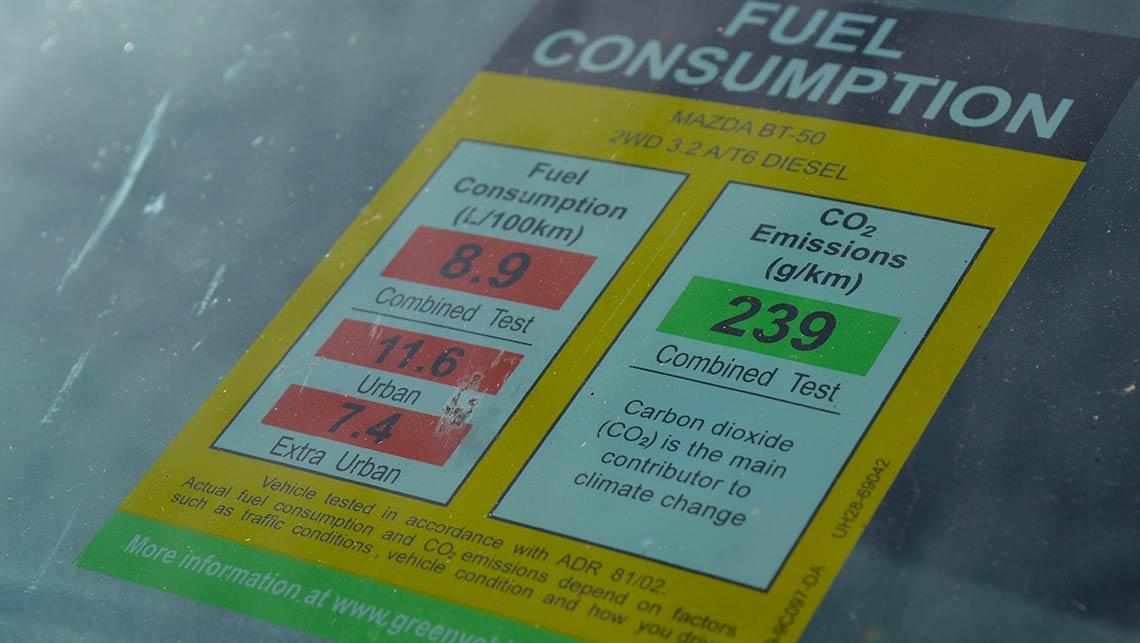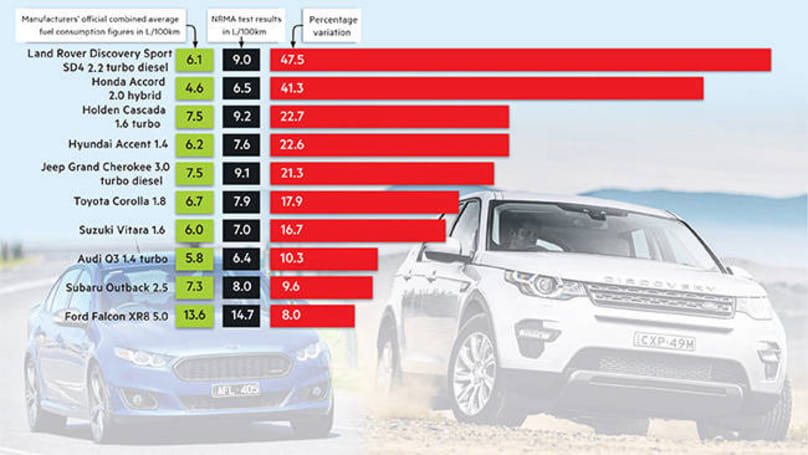
Official vs real-world fuel consumption figures | why do they differ?

When it comes to fuel use, we're being urged to go a deeper shade of green — so you'd think that when you're researching and buying a new car, accurate information about how thirsty and environmentally friendly it is would be freely available and easy to find.
Not so. The opposite is true.
Volkswagen is being hung, drawn and quartered for providing consumers with misleading fuel consumption and emissions figures. The fact is the Australian Government is doing exactly the same.
Fuel consumption figures published on the Green Vehicle Guide (GVG) website by the Department of Infrastructure and Regional Development, and also found on the windscreen stickers on all new cars, can be almost 50 per cent optimistic according to real-world consumption numbers provided to CarsGuide by the NRMA.
The Land Rover Discovery Sport SD4 2.2-litre turbo diesel averages 6.1L/100km according to Land Rover and the Green Vehicle Guide.
When the NRMA tested the vehicle, it averaged 9.0L/100km, or 47.5 per cent more than the official figure.
Australia adopted the European emissions standard and fuel consumption test in 2003. This test is used to obtain the official figures claimed by car makers.
It consists of five simulated city and highway driving cycles over a total of 11km. The test is done in laboratories, not on the road. The car makers themselves do the test and supply the figures to the government, which takes them on face value and publishes them unchecked, with no auditing for accuracy and truthfulness.
Car brands also game the official test setup in tricky and completely unrealistic ways to deliver artificially low numbers
The combined average consumption figure is arrived at by weighting the urban and highway numbers and adding the two to get an average for the final figure.
The fact that 63.1 per cent of the average comes from the highway part of the test explains why the combined figure can be so misleading — unless you do 63.1 per cent of your driving on the highway.
Car brands also game the official test setup in tricky and completely unrealistic ways to deliver artificially low numbers for fuel use and CO2 emissions.
They run extremely high tyre pressures in test cars, disconnect the alternator, leave the aircon off, fill the engine with low friction oil, blueprint the engine, set wheel alignment for minimum drag, test at high altitude and even remove the spare and other equipment to trim weight, which mean vehicles can be tested with less drag on the "rolling road" in the laboratory.
If you live in a capital city and drive in the usual argy-bargy commuter and weekend traffic, your car's actual fuel consumption will always be higher than the official combined average — significantly so in the case of big, heavy cars and 4WDs such as the Land Rover.
The NRMA tests cars on set highway and city routes around Sydney. Cars are filled at the start and finish at the same petrol station, at the same pump (if possible) and are filled to the brim, until fuel is visible in the filler neck. The fuel figures are recorded for both routes and averaged for the test.
The Volkswagen scandal clearly shows that regulators now need to be assessing vehicles in the real world
"The official Australian test doesn't reflect the fuel consumption that owners will get," says NRMA engineer Jack Haley.
"The closer we can get to real world figures, the better."
The Australian Automobile Association said last month that it will also do fuel and emissions tests on 30 popular new cars under real world conditions over the next 18 months.
"The Volkswagen scandal clearly shows that regulators now need to be assessing vehicles in the real world, not just in a laboratory," says AAA head Michael Bradley.
Until recently you could at least compare the overall environmental friendliness of new cars sold in Australia, based on their emissions and fuel consumption, by checking their star ratings (based on a one to five scale with five being the best) on the Green Vehicle Guide website.
You can't do that now, because the Department of Infrastructure has removed the star ratings from the GVG.
ANCAP crash test results were removed earlier.
You have to wonder why the government has now decided to make it much more difficult for consumers to compare the environmental credentials of new cars
A departmental spokesman tells CarsGuide that the GVG "was updated to have a stronger focus on tailpipe CO2 emissions — the main contributor to climate change".
Haley says removing the star ratings is a backward step.
"We opposed it," he says. "It's just made it more difficult for consumers to find the information they want."
In a submission to the green guide review, the AAA cited its survey in which 68 per cent of motorists supported green star ratings. It says: "A simple system is required to provide consumers with guidance and the AAA advocates the retention of a star rating system, as star ratings are familiar to consumers."
CarsGuide first broke this story in 2012, when as part of the GVG review the government proposed to remove the star ratings on January 1, 2013. This was largely due to pressure from the local car industry, notably Ford which was worried about the Falcon's poor GVG performance (3.5 stars) affecting fleet sales, and by the industry representative body, the Federal Chamber of Automotive Industries.
Given that neither the Falcon, nor the FCAI, are particularly relevant in the twilight of local car manufacturing, you have to wonder why the government has now decided to make it much more difficult for consumers to compare the environmental credentials of new cars by removing the GVG star ratings.

Have your say
The Forum on Vehicle Emissions, established by the Australian Government in November, is "an opportunity to fully investigate the issue of vehicle testing as well as many other issues in relation to vehicle emissions," says Minister for Major Projects Paul Fletcher.
Through the year there will be public consultation meetings and a discussion paper seeking feedback.









Comments